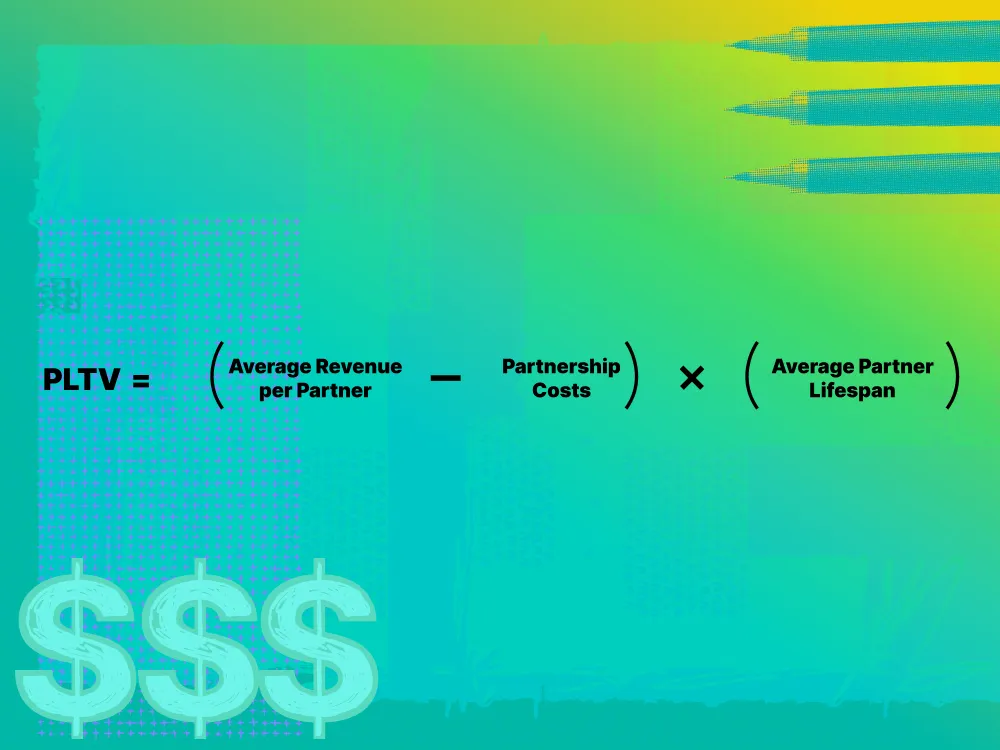Everyone knows partnerships are valuable, but if you can’t quantify those relationships, you’ll struggle to secure buy-in and make strategic decisions. That’s where partner lifetime value (PLV) comes in. PLV is a metric that helps quantify the revenue impact of your partners and partner ecosystem. It enables you to make data-driven decisions about where to focus your time and resources for maximum growth.
In this article, we’ll break down how to calculate PLV, why it matters and how it powers better partnerships and a higher ROI.
What is partner lifetime value (PLV)?
Partner lifetime value (PLV) predicts the total revenue a partner can bring to your business over the course of the partnership. Think of it as a way to forecast how your partnerships will pay off long-term.
PLV can be used to predict the profitability of individual partnerships as well as your partnership channel as a whole, giving you a holistic view of your partner ecosystem. This metric can help partnership managers quantify partner impact and invest in strategies that drive the most return.
See more: 7 ways partner managers are redefining partnerships.
PLV vs. customer lifetime value (CLV)
Partner lifetime value (PLV) is a metric derived from customer lifetime value (CLV), a staple measurement in both B2C and B2B contexts. CLV estimates the average revenue a customer generates throughout their relationship with a business.
While both these metrics measure profitability, they focus on different types of relationships. CLV supports customer-focused strategies, while PLV quantifies partner contributions to optimize partner programs.
How to calculate partner lifetime value (PLV)
Partner lifetime value (PLV) can be measured at different levels:
- Across the entire partnership network
- Within specific segments or groups of partners
- For each individual partner.
To start, let’s look at PLV from a network-wide perspective by starting with the basic variables: average revenue generated per partner and average partner lifespan.
Using the PLV formula
To calculate the average revenue generated by a partner over their lifetime, start with this simple formula:
PLV = (Average Revenue Per Partner) x (Average Partner Lifespan)
- Average revenue per partner: Calculate the average revenue a partner generates in a year. For example, if the total revenue from all partners is $1M per year and you have 200 active partners, the Average Revenue Per Partner would be $5K.
- Average partner lifespan: Estimate how long partners typically stay in the program, in years. For example, if partners typically remain active for an average of three years, then the average partner lifespan is three.
Here’s an example calculation using the formula and examples above:
PLV = ($5,000/year) x (3 years)
PLV = $15,000
In this example, each partner is expected to generate $15K over their lifetime in the program. Remember, this formula gives an average estimate. Actual PLV can differ significantly across partners and partner segments.

Including partnership costs
Every partnership program has expenses, from onboarding and training to marketing materials and partner commissions. To factor in these costs, adjust the Average Revenue per Partner by subtracting the annual expenses associated with each partnership.
Here’s the updated formula:
PLV = (Average Revenue Per Partner - Partnership Costs) x (Average Partner Lifespan)
This formula provides a more accurate PLV by predicting profitability while considering the ongoing costs of running the program.
Considering partner churn rate
While the PLV formula already includes average partner lifespan, an alternative method of estimating it is by using churn rate. Partner churn rate is the rate at which partners leave the program, expressed as a percentage per year.
If you decide to go this route, here’s how you can calculate it:
Average Partner Lifespan = 1 / Partner Churn Rate
For example, if the Partner Churn Rate is 20% (or 0.20), then:
Average Partner Lifespan = 1 / 0.20 = 5 years
Leveraging churn rate can be useful if you don’t have reliable data to estimate partner lifespan accurately or for programs with high turnovers.
Related: Customer churn reduction strategies to get ahead.
Why calculating partner lifetime value is important for growth
PLV allows you to bring a performance mindset to partnerships and enables data-driven decision making. Once you know your PLV, you’re armed with data that helps you set goals, allocate resources effectively and focus on partnerships that drive the most growth.
PLV identifies high-value partners
Partner lifetime value can be a powerful tool to help you spot high-value partners worth prioritizing. By using PLV as a benchmark for average revenue and lifespan, you can quickly identify top-performing partners that generate the highest ROI.
For instance, if your average PLV is $5,000, but some partners generate more than $10,000, you’ll want to reward these partners with a dedicated account manager, co-branded marketing materials, and higher commission tiers.

Understanding PLV improves partner retention and reduces churn
Reducing churn is an ongoing priority for partnership managers. If partners leave your program, they stop generating revenue for your program.
Regularly monitoring PLV can be helpful for identifying partner retention gaps and fixing them. For example, suppose you analyze your PLV and discover certain top-performing partners tend to churn after two years. To encourage them to stay longer, you could create a loyalty-based incentive structure with milestone rewards and bonus tiers.
Tools for calculating PLV
Calculating PLV requires tools that can track key metrics such as partner retention, revenue contribution and engagement data. While spreadsheets or simple predictive models can work, a dedicated partner relationship management (PRM) platform like PartnerStack makes it simple and scalable.
PartnerStack is designed specifically for B2B companies to streamline their partner ecosystem management and offers a variety of features that are particularly useful for calculating PLV. Revenue tracking and partnership-focused performance analytics simplify the PLV calculation process and help maximize the value of your partner programs.
Partner lifetime value is the data backbone of a strong partner program. With PLV, you can identify high-value partners, address blind spots and make data-driven decisions that strengthen your entire partner ecosystem.

















